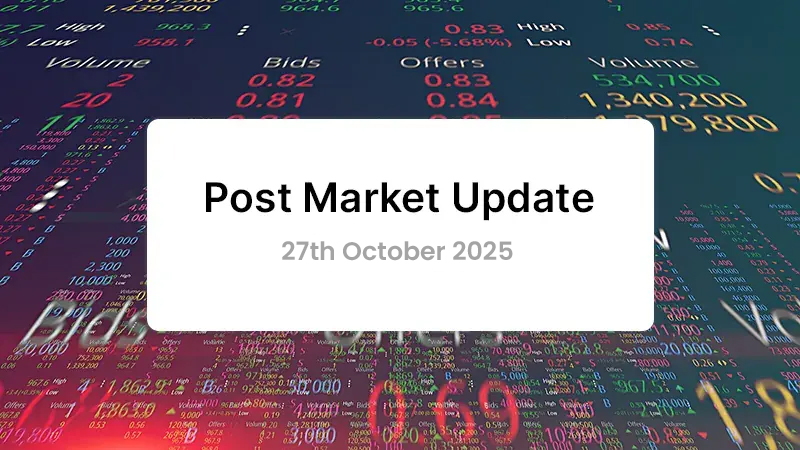
After four consecutive years of solid gains following the sharp rebound from the Covid-19 crash, Indian equity markets finally seem to be losing momentum. For the first time since 2020, the one-year period from late September 2024 to late September 2025 has seen major indices deliver negative returns, breaking the post-pandemic streak of annual growth.
From the market peak around September 26, 2024, benchmark indices have slipped by roughly 7–7.5 per cent year-on-year, signalling that investors are now facing a different phase — not a sharp correction, but a prolonged period of consolidation. Earlier September-to-September cycles had all recorded healthy gains, underscoring how this shift represents a clear pause in an otherwise resilient run.
In other words, the market isn’t collapsing — it’s catching its breath. Prices are fluctuating within a range, valuations remain elevated, and investor enthusiasm has cooled just enough to make the next direction uncertain. This kind of environment — a sideways market — can be frustrating for traders, but for long-term investors, it presents a crucial opportunity to rebalance, rethink, and reinforce their portfolios.
The Patience Trap in a Flat Market
Sideways markets tend to lull investors into a false sense of inactivity. With prices barely moving, it’s easy to believe nothing needs to be done. But inactivity without intention can be just as harmful as overtrading.
When market momentum stalls, portfolios can stagnate, particularly if they are overly concentrated in sectors that previously led the rally — such as small caps or select thematic funds. In these phases, complacency becomes risk. If investors continue to hold last cycle’s winners without reassessing fundamentals, they could end up stuck in underperforming assets just when leadership begins to shift.
A sideways market is not a time to do nothing — it’s a time to reposition smartly.
Focus on Asset Allocation, Not Stock Selection
When returns from equities flatten, portfolio performance is driven more by asset mix than by specific stock picks.
This is the phase where investors should step back and ask: Is my portfolio built to weather volatility without losing direction?
Rebalancing — often overlooked in bull runs — becomes critical now. For instance, an investor whose portfolio ballooned with mid- and small-cap exposure over the past two years might now find over 50 per cent sitting in high-risk categories. Redeploying some of that into large-cap or global funds can help balance risk and preserve long-term gains.
Equally, allocating part of one’s corpus to alternative investment options — such as AIFs, international equity feeders, or structured debt strategies — can diversify sources of return. A sideways domestic market need not mean a sideways portfolio.
Cash Flow and Liquidity: The Hidden Strength
In uncertain markets, liquidity is power. Many investors underestimate the importance of maintaining cash buffers or liquid-fund exposure, especially after long equity rallies. But this cash isn’t about timing the market — it’s about buying flexibility.
When valuations reset or new opportunities emerge, liquid capital allows you to act without having to sell existing investments at unfavourable levels. Moreover, maintaining adequate liquidity ensures that you’re not forced to borrow or redeem long-term holdings to meet short-term expenses — a key reason why many households end up accumulating unproductive debt.
Avoid the “Consumption Financing” Mindset
In personal finance, not all borrowing is created equal. Loans taken for asset creation — such as a home or education — can enhance long-term wealth or earning potential. But borrowing for consumption, especially to sustain lifestyle upgrades, can silently erode future financial stability.
In the current market environment, with costs of living and interest rates still elevated, investors must be extra cautious. Using credit to invest or spend is tempting when asset prices seem stable. Yet, sideways markets can persist longer than expected, making leverage a costly gamble.
The smarter move is to keep liabilities light, redirect savings toward productive assets, and ensure that debt, if any, has a clear purpose.
Look Beyond the Obvious: Quality Over Quantity
Sideways phases separate investors from speculators. In a bull market, even mediocre companies tend to rise with the tide; in a flat market, only quality delivers. This is the time to scrutinize holdings with a critical eye — focus on businesses with strong balance sheets, stable cash flows, and managements that can sustain earnings even in muted growth cycles.
Equity fund investors can follow a similar principle: consolidate into high-quality funds with consistent risk-adjusted returns rather than chasing the latest outperformer. Funds that demonstrate disciplined asset allocation, prudent risk controls, and global diversification can outperform over full cycles, even if they appear slow in momentum-driven markets.
Global Diversification and Professional Oversight
One common mistake in sideways markets is to assume that stagnation is universal. Global markets often move in different cycles. Investors with concentrated domestic exposure could benefit from international diversification — either through feeder funds, global ETFs, or professionally managed AIF structures via platforms like the GIFT City route.
Working with a professional global fund manager offers not just geographical diversification, but also a structured approach to risk and opportunity identification — something retail investors often lack during dull phases.
Stay Invested, but Stay Intentional
The worst mistake in a sideways market is to lose conviction. Long-term wealth creation rarely follows a straight line; instead, it builds quietly during phases of consolidation.
Sideways markets give investors the rare gift of time — time to reassess goals, rebalance portfolios, and strengthen foundations. They test temperament more than intelligence.
Those who stay invested with discipline, diversify intelligently, and avoid emotional decisions often find that the next upcycle rewards their patience many times over.
In essence, a sideways market is not a dead market. It’s a reset phase — a period where leadership changes, valuations normalize, and the seeds of the next rally are sown. For investors, the playbook is simple but powerful:
- Rebalance toward quality and diversification.
- Keep liquidity handy.
- Avoid unproductive debt.
- Use professional management when possible.
- And above all, stay patient.
Because markets, much like time, eventually move forward — but only the prepared investor moves with them
Market this week
| 16th Nov 2025 (Open) | 21st Nov 2025 (Close) | %Change | |
| Nifty 50 | ₹ 25,948 | ₹ 26,068 | 0.5% |
| Sensex | ₹ 84,701 | ₹ 85,232 | 0.6% |
Source: BSE and NSE
- Indian equity benchmarks extended their winning streak for the second straight week, though trading remained volatile amid multiple global and domestic cues.
- Market sentiment was influenced by the delay in the US–India trade deal, mixed signals on potential US Fed rate cuts following strong non-farm payroll data, a weakening rupee, and subdued domestic manufacturing PMI figures.
- Sector-wise performance was mixed, with Nifty IT gaining 6% on improved global tech sentiment, Nifty Auto advancing 1% amid steady retail demand, and Nifty Bank rising 0.6% on stable credit growth trends, while Nifty Realty fell 3.7%, Nifty Metal declined 3.3%, and Nifty Media slipped 2.4% due to profit booking and global demand concerns.
- On the fund flow front, Foreign Institutional Investors (FIIs) curtailed their selling, offloading equities worth ₹188 crore, while Domestic Institutional Investors (DIIs) continued strong buying, accumulating stocks worth ₹12,969 crore during the week
Weekly Leaderboard
| NSE Top Gainers | NSE Top Losers | ||||
| Stock | Change (%) | Stock | Change (%) | ||
| Hero MotoCorp | ▲ | 8.4% | TATA Motors Pass | ▼ | -7.4% |
| Eicher Motors | ▲ | 6.6% | Adani Enterprises | ▼ | -3.7% |
| Bharti Airtel | ▲ | 2.9% | Jio Financial Services | ▼ | -3.6% |
| Infosys | ▲ | 2.8% | TATA Steel | ▼ | -3.6% |
| Axis Bank | ▲ | 2.7% | Hindalco Industries | ▼ | -3.2% |
Source: BSE
Stocks that made the news this week:
Groww:
Shares of Billionbrains Garage Ventures, the parent company of stockbroking platform Groww, surged over 7% on November 21 ahead of its Q2 FY26 results announcement. The rally pushed its market capitalisation past ₹1 lakh crore once again, rebounding after a two-day decline that had wiped out ₹23,000 crore in value. At ₹168.39 per share, Groww trades 50% above its listing price and 68% above its IPO price, showing strong investor interest since its November 12 debut.
IndusInd Bank:
IndusInd Bank shares jumped over 3% to ₹856.80, topping the Nifty Bank gainers’ list on November 21. The rebound ended a three-session losing streak, coming despite the bank’s clarification denying reports of a possible $1-billion fundraise. Earlier reports suggested the lender was exploring options like a QIP or preferential issue, fueling temporary market speculation.
Mahindra & Mahindra:
Mahindra & Mahindra (M&M) was among the top gainers on the Nifty50, rising sharply after the company unveiled an ambitious plan to grow its auto business revenue eight-fold by FY30 compared to FY20. The group reported ₹90,825 crore in consolidated auto revenue for FY25, a 3.2x increase over FY20, and aims to sustain momentum with a stronger focus on SUVs and light commercial vehicles (LCVs)














